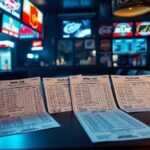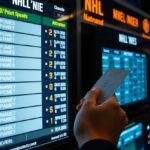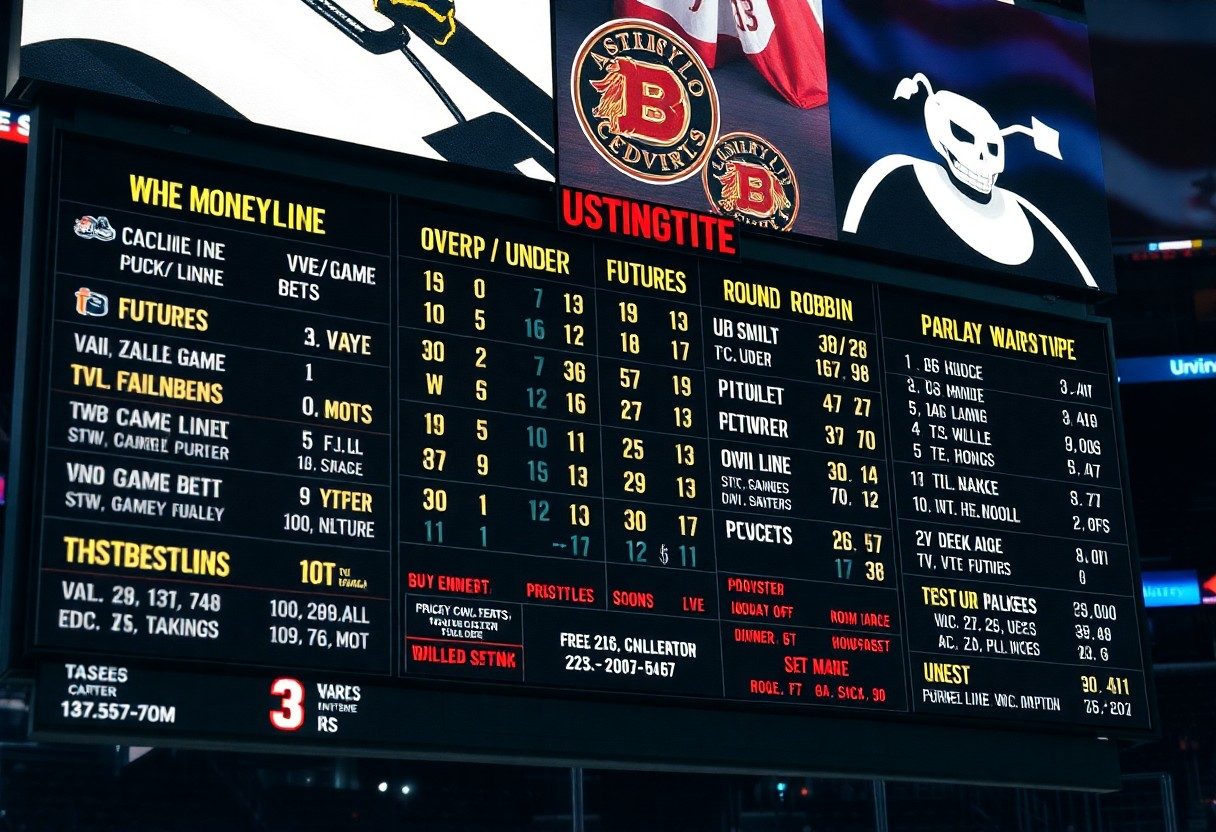Most new hockey bettors fall into several pitfalls that can undermine their wagering success. Understanding key strategies and avoiding emotional betting are crucial for making informed decisions. Many beginners neglect to research teams and their performance statistics, leading to misguided bets. In this post, we will outline common mistakes and provide insights that can enhance your betting experience and increase your potential for profit. Stay informed and approach your bets with a tactical mindset.
Understanding Hockey Betting Basics
Comprehending the fundamentals of hockey betting lays the groundwork for successful wagering. Bettors should familiarize themselves with odds, point spreads, and the significance of moneyline betting. With these basics, you can gauge the potential outcomes of a game and make informed decisions, reducing the likelihood of common betting errors.
Key Terminology
New bettors must grasp imperative terms like puck line, over/under, and juice. Understanding these concepts will equip you to navigate various betting options more effectively, enhancing your overall strategy. Bettors often overlook the consequences of not knowing these definitions, which can lead to costly mistakes.
Different Types of Bets
Hockey offers various betting types, including moneyline bets, puck line bets, and over/under bets. Moneyline bets involve selecting a team to win outright, while puck line bets require predicting a team’s margin of victory. Over/under bets focus on total goals scored in a game. Each type has its nuances, and varying strategies can significantly impact outcomes.
| Bet Type | Description |
| Moneyline | Bet on a team to win straight up. |
| Puck Line | Bet on a team to win by a specific margin. |
| Over/Under | Bet on total goals scored in a game. |
| Parlay | Combine multiple bets for greater payout potential. |
| Prop Bets | Bet on specific events within a game. |
Understanding the different types of bets broadens your options and helps tailor your betting strategies. For instance, moneyline bets are straightforward but may yield lower returns, while parlay bets can multiply winnings. Prop bets, on the other hand, allow for unique engagements with individual player performances. Recognizing the strengths and weaknesses of each option can elevate your betting prowess.
- moneyline bets are direct wins
- puck line bets involve point spread
- over/under bets target game totals
- parlays combine multiple outcomes
- props focus on specific events
Recognizing these betting types and their implications can lead to better decision-making in your betting strategy.
Research and Analysis
Effective hockey betting relies heavily on thorough research and analysis. Bettors must investigate into statistics, previous game outcomes, and matchup specifics to make informed decisions. Understanding factors such as home vs. away performance, recent winning streaks, and injury reports can significantly influence betting outcomes. Utilizing tools like advanced analytics and historical data trends can provide a competitive edge, enabling smoother navigation through betting options and clearer identification of valuable bets.
Team Performance Metrics
Analyzing team performance metrics offers invaluable insights for bettors. Factors like goals scored versus goals allowed, power play percentages, and penalty kill effectiveness highlight a team’s strengths and weaknesses. Bettors should focus on metrics like Corsi and Fenwick ratings to understand shot metrics and puck possession. By synthesizing these statistics, bettors can gauge how teams might perform against each other, leading to more accurate predictions.
Player Statistics
Player performance plays a pivotal role in betting outcomes. Metrics such as goals, assists, plus/minus ratings, and time on ice can indicate a player’s impact on the game. Bettors should also consider a player’s average points per game and consistency over the season, enabling a deeper understanding of their contributions under varying circumstances.
Looking further into player statistics, pay attention to advanced stats like expected goals (xG) and points per 60 minutes (P60). These statistics provide insight into a player’s efficiency and scoring potential relative to ice time. Comparisons among players, especially in key matchups, help assess which players are likely to outperform expectations. Tracking a player’s recent form and any notable shifts in their performance can also reveal trends that impact game outcomes, enhancing overall betting strategies.
Bankroll Management
Effective bankroll management is the backbone of successful hockey betting. Establishing a clear strategy prevents emotional decision-making and mitigates losses. A disciplined approach allows bettors to engage with the sport while maintaining financial stability, ultimately enhancing the overall betting experience.
Setting a Budget
Setting a budget involves determining how much money can be allocated for betting without impacting personal finances. This budget should be strictly adhered to, with bettors ideally only using funds they can afford to lose. A typical guideline is to set aside 1-5% of the total bankroll for individual bets, promoting longevity in the betting landscape.
Staking Strategies
Staking strategies help bettors decide how much to wager on each bet while considering their overall budget and risk tolerance. Common methods include flat betting, where a fixed amount is staked each time, and percentage betting, where a set percentage of the bankroll is wagered. Evaluating these approaches can significantly impact long-term profitability.
Flat betting simplifies the process, ensuring consistent wagers that shield the bankroll from drastic fluctuations. For instance, if a bettor has a $1,000 bankroll and chooses to stake $50 each time, they maintain steady participation. On the other hand, percentage betting adapts to financial success or failures. Using the same $1,000 bankroll, if a bettor decides on a 3% stake, they would wager $30 initially, adjusting the amount as the bankroll fluctuates. This dynamic approach caters to varying risk levels and helps in making informed betting decisions based on current funds.
Common Mistakes to Avoid
New hockey bettors often stumble upon several common pitfalls that can hinder their success. A lack of understanding regarding betting strategies and insufficient attention to relevant information can lead to poor decisions. Avoiding these mistakes can significantly enhance a bettor’s experience and potential returns.
Chasing Losses
Chasing losses often leads to impulsive betting decisions. After experiencing a setback, bettors may increase their wager amounts in a desperate attempt to recover funds. This approach typically compounds losses rather than providing a genuine opportunity to regain prior bets, fostering a cycle of frustration and financial instability.
Ignoring Game Context
Understanding the context of a game is vital for informed betting. Factors such as player injuries, team morale, and fatigue can dramatically impact performance. Ignoring these elements may lead to misguided bets; for instance, betting on a team with stars missing significant games can diminish the likelihood of a favorable outcome.
Analyzing team context requires more than just numbers on paper. It involves evaluating recent performances, team dynamics, and external circumstances like travel schedules and weather conditions. A recent example is Team A struggling after a long road trip while Team B benefits from home ice advantage. Such nuances provide valuable insights, helping bettors make more educated selections and avoid costly mistakes. Each game tells a story that statistics alone cannot convey; understanding it can mean the difference between winning and losing bets.
Staying Informed
Accessing reliable information can significantly impact betting decisions. New bettors should immerse themselves in the latest news, injury reports, and roster changes, as player conditions can shift outcomes drastically. Following team dynamics and recent performance trends will sharpen analysis, leading to more informed bets. Engaging with reliable sources can provide a competitive edge, allowing bettors to identify value opportunities.
Following Expert Insights
Expert opinions can reveal hidden betting opportunities that may not be evident from statistics alone. Industry analysts often share predictions based on in-depth knowledge, which can enhance a bettor’s strategy. Engaging with expert commentary through podcasts, articles, or social media can offer additional perspectives on matchups and team performance.
Utilizing Betting Tools
Advanced betting tools offer an array of features, from live odds tracking to predictive analytics, which can sharpen decision-making. Utilizing these resources allows bettors to quickly make informed adjustments based on real-time data and trends. Specific tools like expected goals statistics and betting calculators can also demystify complex odds, ensuring bets are placed with a firm understanding of potential outcomes.
Utilizing betting tools not only simplifies the decision-making process but also brings clarity to betting strategies. Tools such as BetMGM or Odds Shark can help bettors track line movements and identify value bets. Reviews and simulations from platforms like Pro Hockey Focus provide data-driven insights that highlight a team’s strength or weaknesses across various scenarios. By leveraging these resources, bettors can formulate tactical approaches tailored to specific games or ongoing season trends, thereby enhancing their overall betting acumen.
Emotional Discipline
Emotional discipline is vital for new hockey bettors to avoid pitfalls that can impact their bankrolls. Staying calm in the face of unpredictable outcomes forms the bedrock of effective betting strategies. Developing a mindset focused on logical analysis rather than reactionary emotion equips bettors to evaluate situations more clearly and resist the lure of following trends driven by hype.
Managing Expectations
Setting realistic expectations is fundamental for beginners in hockey betting. Many newcomers envision immediate success, often influenced by stories of big wins. Accepting the learning curve and recognizing that losses are part of the process helps maintain a healthy perspective, ensuring decisions are grounded in strategy rather than wishful thinking.
Avoiding Impulsive Decisions
Impulsive decisions can lead to significant losses in hockey betting. Acting on a whim without thorough research can result in poor bets driven by fleeting emotions. Establishing a betting plan that incorporates a cooling-off period after losses prevents the urge to chase losses and fosters disciplined decision-making.
Impulsive decisions typically arise from emotional responses rather than calculated strategies. For instance, a bettor who has just experienced a loss may feel compelled to place an immediate bet to recover funds, bypassing crucial analysis. This often leads to betting on teams without considering the odds, player injuries, or matchups, ultimately exacerbating financial strains. Effective bettors utilize practices such as waiting a day before placing bets post-loss, allowing time to reevaluate their strategy and detach from emotionally charged decisions.
Conclusion
Taking this into account, new hockey bettors can enhance their chances of success by avoiding prevalent pitfalls. By focusing on informed decision-making, managing bankrolls wisely, and understanding team dynamics and game statistics, bettors can navigate the complexities of hockey wagering more effectively. Being mindful of the psychological aspects of betting and continually educating oneself will foster a more disciplined approach, ultimately leading to a more rewarding betting experience.
FAQ
Q: What are common mistakes new hockey bettors make regarding bankroll management?
A: New hockey bettors often fail to set a budget or bankroll, leading to overspending. It’s important to establish a limit on how much to wager and stick to it. This helps maintain control and prevents emotional betting after losses.
Q: How does lack of research affect new hockey bettors?
A: New bettors frequently overlook the importance of research, which can lead to poor decision-making. Understanding team statistics, player conditions, and recent performance trends can significantly influence betting outcomes. Always conduct thorough research before placing any bets.
Q: Why is it a mistake to bet on favorites without consideration?
A: Many new bettors tend to place bets on favorites without assessing value or odds. Betting on a team simply because they are favored can result in losses, especially if the odds do not provide sufficient return. It’s necessary to analyze the odds and find value in bets, rather than relying solely on favorites.












